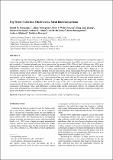Fog Water Collection Effectiveness: Mesh Intercomparisons
Author(s)
Fernandez, Daniel M.; Oliphant, Andrew; Bowman, Matthew; Torregrosa, Alicia; Weiss-Penzias, Peter S.; Zhang, Bong June; Sorensen, Deckard; Cohen, Robert E; McKinley, Gareth H.; Kleingartner, Justin Alan; ... Show more Show less
DownloadGHM275.pdf (1.191Mb)
OPEN_ACCESS_POLICY
Open Access Policy
Creative Commons Attribution-Noncommercial-Share Alike
Terms of use
Metadata
Show full item recordAbstract
To explore fog water harvesting potential in California, we conducted long-term measurements involving three types of mesh using standard fog collectors (SFC). Volumetric fog water measurements from SFCs and wind data were collected and recorded in 15-minute intervals over three summertime fog seasons (2014–2016) at four California sites. SFCs were deployed with: standard 1.00 m[superscript 2] double-layer 35% shade coefficient Raschel; stainless steel mesh coated with the MIT-14 hydrophobic formulation; and FogHa-Tin, a German manufactured, 3-dimensional spacer fabric deployed in two orientations. Analysis of 3419 volumetric samples from all sites showed strong relationships between mesh efficiency and wind speed. Raschel mesh collected 160% more fog water than FogHa-Tin at wind speeds less than 1 m s[superscript –1] and 45% less for wind speeds greater than 5 m s[superscript –1]. MIT-14 coated stainless-steel mesh collected more fog water than Raschel mesh at all wind speeds. At low wind speeds of < 1 m s[superscript –1] the coated stainless steel mesh collected 3% more and at wind speeds of 4– 5 m s[superscript –1], it collected 41% more. FogHa-Tin collected 5% more fog water when the warp of the weave was oriented vertically, per manufacturer specification, than when the warp of the weave was oriented horizontally. Time series measurements of three distinct mesh across similar wind regimes revealed inconsistent lags in fog water collection and inconsistent performance. Since such differences occurred under similar wind-speed regimes, we conclude that other factors play important roles in mesh performance, including in-situ fog event and aerosol dynamics that affect droplet-size spectra and droplet-to-mesh surface interactions. Keywords: Fog mesh, Fog water collection efficiency, Raschel mesh, Hydrophobic coating
Date issued
2018-12Department
Massachusetts Institute of Technology. Department of Chemical EngineeringJournal
Aerosol and Air Quality Research
Publisher
Taiwan Association for Aerosol Research
Citation
Fernandez, Daniel M., Justin Kleingartner, Andrew Oliphant, Matthew Bowman, Alicia Torregrosa, Peter S. Weiss-Penzias, Bong June Zhang, Deckard Sorensen, Robert E. Cohen, and Gareth H. McKinley. “Fog Water Collection Effectiveness: Mesh Intercomparisons.” Aerosol and Air Quality Research 18, no. 1 (2018): 270–283.
Version: Author's final manuscript
ISSN
20711409
1680-8584